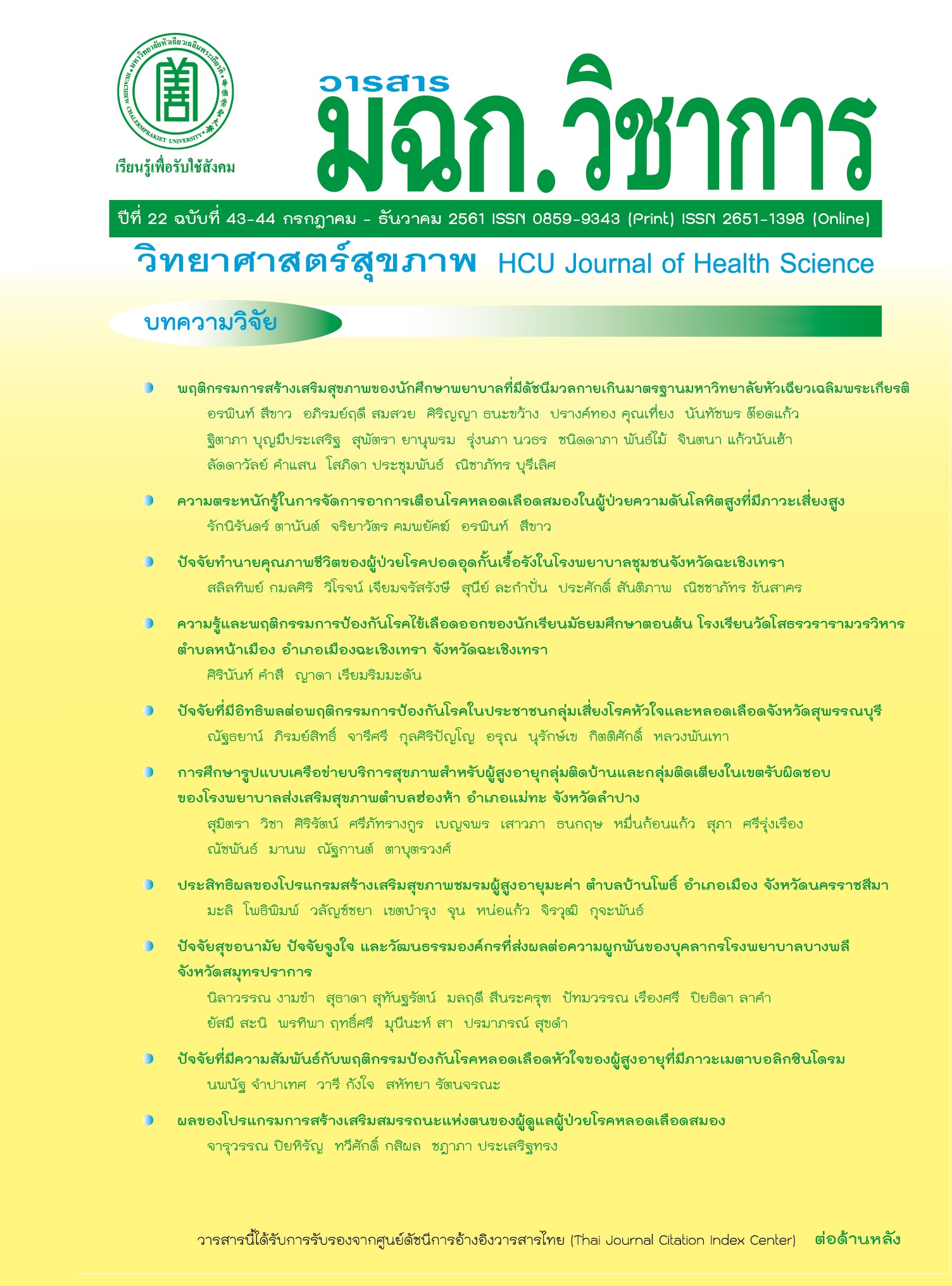Effects of a Self-Efficacy Promotion Program for Stroke Caregivers
Keywords:
Stroke, self-efficacy, caregivers of stroke patientsAbstract
The purposes of this one group quasi-experimental research was to investigate self-efficacy perception of caregivers caring for stroke patients before and after attending self-efficacy promotion program, and at the follow-up stage; and to compare the physical condition of stroke patients, focusing on pneumonia and bedsore. The self-efficacy promotion program based on Bandura’s theory was developed focusing on pneumonia and bedsore prevention. There were 10 caregivers of stroke patients who participated first time in this study. The experiment consisted of 2 stages. The first stage, of the program was delivered to the caregivers as home visits 4 times in 4 day, taking 1-2 hours at a time. The second stage started a week after the patients were discharged. The caregivers were approached through home visit on the first week by video calls once a week for 3 weeks; then home visit within 28 days afterward was performed for follow-up with in 28 day and the effects of the program were measured. Data were analyzed by using Wilcoxon signed rank test. The incidences for pneumonia and bedsore were assessed by using the Physical Examination Form.
The results revealed that the scores of caregivers ’ perception on self – efficacy after attending the program was higher than before attending the program. After attending the program and follow-up scores were higher than before significantly by.01. For the physical condition assessments of the stroke patients at those 3 times of measurements, they had no pneumonia symptom and bedsore. The study suggested that the program should be applied in the development plan to enhance self-care ability and efficacy of caregivers in caring for stroke patients.
Downloads
References
Nov 20]. Avaliable from: https://www.who.int/topics/cerebrovascular_accident/en
2. Armin J. Grau, Christian Urbanek and Frederick Palm. Common infections and the risk of stroke [Internet]. 2010 [cited 2017
Nov 20]. Available from: https://www.mitpressjournals.org/doi/abs/10.1162/rest_a_00004
3. Zhang LF, Yang J, Hong Z, Yuan GG, Zhou BF, Zhao LC, et al. Proportion of different subtypes of stroke in china Stroke 2003;34:2091-6.
4. ปิติกานต์ บูรณาภาพ. คู่มือดูแลผู้ป่วยอัมพฤกษ์ อัมพาต. กรุงเทพมหานคร: ยูโรปาเพรส; 2552.
5. นิชธิมา ศรีจำนงค์. ผลของโปรแกรมส่งเสริมการรับรู้ความสามารถของตนเองของญาติผู้ดูแลผู้ป่วยโรค
หลอดเลือดสมองที่บ้าน. วารสารวิทยาลัยพยาบาลบรมราชชนนีกรุงเทพ. 2553;26(1):28-43.
6. สวรินทร์ หงษ์สร้อย, วัลภา คุณทรงเกียรติ, เขมารดี มาสิงบุญ. ผลของโปรแกรมส่งเสริมความสามารถผู้ดูแลอย่างต่อเนื่องต่อความสามารถในการดูแลของผู้ดูแลความสามารถในการทำกิจกรรมและการเกิดภาวะแทรกซ้อนในผู้ป่วยโรคหลอดเลือดสมองชนิดขาดเลือด. วารสารการพัฒนาชุมชนและคุณภาพชีวิต. 2556;1(1):77-89.
7. จิตลัดดา ประสานวงศ์,ปฐมวดี สิงห์ดง, รสสุคนธ์ สามแสน. การพัฒนาระบบการดูแลผู้ป่วยโรคหลอดเลือดสมอง โรงพยาบาลศรีสะเกษ วารสารกองการพยาบาล. 2555;39(2):51-6.
8. อุมา จันทวิเศษ, พรชัย สถิรปัญญา, ฉมาภรณ์ วรกุล, ยุพิณ วัฒนสิทธิ์, ฉวีวรรณ ยี่สกุล, สิรินทร์ ศาสตรานุรักษ์. ผลลัพธ์การใช้แผนการดูแลผู้ป่วยโรคหลอดเลือดสมองตีบและอุดตันในโรงพยาบาลสงขลานครินทร์. สงขลานครินทร์เวชสาร. 2552;27(2):117-29.
9. นงนุช เพ็ชรร่วง, ปนัดดา ปริยทฤฆ, วิโรจน์ ทองเกลี้ยง. การศึกษาการดูแลผู้ป่วยโรคหลอดเลือดสมองอย่างต่อเนื่องในศูนย์สุขภาพชุมชน. วารสารพยาบาลทหารบก. 2556;14(1):25-34.
10. อมรวรรณ กวีภัทรนนท์. ผลของการส่งเสริมสมรรถนะแห่งตนในการดูแลผู้ป่วยของผู้ดูแลผู้ป่วยโรคหลอดเลือดสมองในระยะเปลี่ยนผ่านจากโรงพยาบาลสู่บ้าน. วารสารพยาบาลศาสตร์ จุฬาลงกรณ์มหาวิทยาลัย. 2556;25(1) :93-105.
11. Bandura A. Social foundation of thoughts and action: A social cognitive theory. Englewood Clifts: NJ: Prentice-Hall; 1986.
12. Cohen, J. Statistical power analysis for the behavioral sciences. New Jersey: Hillsdale; 1988
13. นิภาพร ประจัญบาน. โปรแกรมการส่งเสริมความสามารถของผู้ป่วยและญาติในการดูแลผู้ป่วยภาวะหัวใจล้มเหลวต่อการกลับเข้ารักษาซ้ำในโรงพยาบาล [ วิทยานิพนธ์]. นครปฐม:มหาวิทยาลัยมหิดล; 2550.
Downloads
Published
How to Cite
Issue
Section
License
บทความที่ได้รับการตีพิมพ์เป็นลิขสิทธิ์ของวารสารวิทยาศาสตร์สุขภาพและสุขภาวะ
ข้อความที่ปรากฏในบทความแต่ละเรื่องในวารสารวิชาการเล่มนี้เป็นความคิดเห็นส่วนตัวของผู้เขียนแต่ละท่านไม่เกี่ยวข้องกับมหาวิทยาลัยหัวเฉียวเฉลิมพระเกียรติ และคณาจารย์ท่านอื่นๆในมหาวิทยาลัยฯ แต่อย่างใด ความรับผิดชอบองค์ประกอบทั้งหมดของบทความแต่ละเรื่องเป็นของผู้เขียนแต่ละท่าน หากมีความผิดพลาดใดๆ ผู้เขียนแต่ละท่านจะรับผิดชอบบทความของตนเองแต่ผู้เดียว




